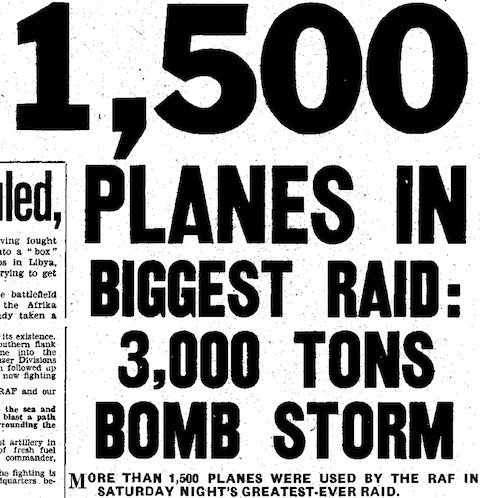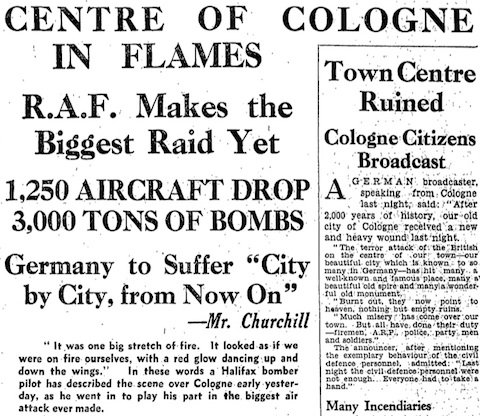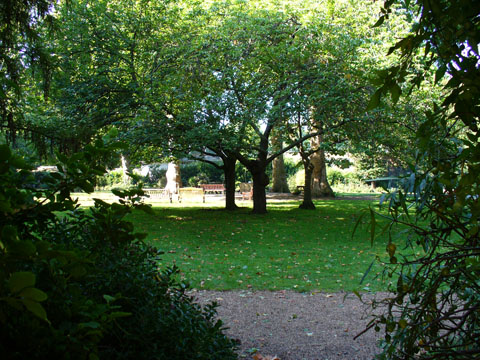As with the Lübeck and Rostock raids over a month earlier, the RAF’s thousand bomber raid on Cologne on 30 May 1942 triggered reprisal attacks by the Luftwaffe (though in far smaller numbers than Bomber Command was able to muster). Another round of Baedeker raids, in other words. This time, however, there was only one target, Canterbury, the site of the Mother Church of the Anglican Communion, bombed on the nights 31 May, 2 and 6 June. In fact, in this period some towns received even heavier raids than Canterbury, such as Southampton and Poole, but are not usually considered part of the Baedeker Blitz, nor were they given then same publicity at the time. The reason for this is presumably that whatever their heritage value those places were also quite clearly valid military targets, whereas Canterbury equally clearly was not. And the Germans didn’t claim they were ‘a reprisal for the terrorist attack carried out by the British Air Force on the inner city of Cologne’, as they did in Canterbury’s case.1
So here I’ll look at the press reports of the Canterbury raids. One of the first was in the Derby Evening Telegraph on 1 June, which reported that ‘CANTERBURY IS HUNS’ TARGET’:
No doubt the Cathedral, the Mother Church of England, was one of the enemy’s chief objectives, but it is not proposed to assist the Germans by giving any information as to whether damage was caused to it or not.2
But since the article went on to describe ‘One of the town’s churches’ as a ‘burned out ruin’, spire crashing into the ruins and all, it’s possible that some readers drew the wrong conclusion and feared the worst. The morning papers the following day still weren’t commenting on the cathedral’s fate, in fact they largely avoided admitting that it existed at all (though they did mention that the Archbishop was safe, which would seem to imply the existence of his cathedral). Instead, the Daily Mirror focused on the human aspects of the raid, leading with the 75-year old woman said to have a ‘spirit […] typical of the Canterbury people’:
She had been buried seven hours beneath 14 feet of debris, but she walked out. While soldiers were digging to free her she called out, ‘I could do with a cup of tea, boys.’3
There were of course those who were not so lucky, including the town clerk, G. W. Marks, who was rescued from the ruins of his house alive but died in hospital. (Marks, who was Canterbury’s ARP controller, was remembered in the West Country as he had been the chief assistant town clerk in Bristol.)4 Even though the raiding force was only about 25 aircraft, the Daily Express‘s report indicates fairly heavy damage:
In Canterbury a number of people were killed and injured, scores of homes, two rest centres, two banks, a school, several inns wrecked or damaged.
But it went on to say that ‘by nightfall all homeless had been clothed, fed and removed in coaches to private homes or rest centres in other areas’. Lord Monsell, the local civil defence commissioner, sounded pleased: ‘The area’s mutual aid scheme has worked well’.5 Incidentally, the raid caused the sirens to sound in some parts of London, only ‘the second night warning in the capital in seven months’.6
The second Canterbury raid, on 2 June, did not receive the same, detailed coverage that the first one did. In fact, it seems not have been officially confirmed at all. Instead the story had to be pieced together from vague reports of an air raid that night and the German version of same, as the Manchester Guardian did:
Giving ‘details’ of a raid on Canterbury on Tuesday night [2 June 1942] — when, according to official Air Ministry reports, a small number of ‘planes visited South-east England — a Berlin military spokesman said that ‘in a cloudless sky and in good visibility German bombers attacked the town in several waves. In spite of the large number of night fighters they penetrated well over the centre of the city and dropped heavy bombs. The crews observed bomb hits in the inner town and near the Cathedral, where large fires were seen.’ The German bombers, he added, continued the attack with high-explosives and incendiaries ‘for several hours.’7
The same happened with the third and last raid on 6 June. So for example the Western Daily Press reported, as part of a lengthy summary of recent air activity by both sides, that:
High explosive and incendiary bombs were dropped on the outskirts of a South-East town, but the raid was a short one. The Germans stated that Canterbury was again raided on Saturday night.8
Near the end of June a number of newspapers carried detailed stories about the damage done to Canterbury Cathedral, along with photographs, finally confirming that it had indeed been damaged, presumably in the first raid though this is nowhere stated. According to the Times‘s special correspondent, half a dozen high explosive bombs cratered the cathedral grounds and twice as many incendiaries were contained by the firewatchers stationed on the roof. The main casualty was the cathedral’s library which was destroyed almost completely, though it only dated to the 19th century and the books themselves seem to have largely escaped. Otherwise:
A few cracks were made by blast in the fabric of the cathedral, including one in the [14th century] chapter house, and here and there stone mullions and tracery of windows were splintered. Though the remaining glass was broken all the really important old stained glass had been removed to safety with the other chief treasures of the cathedral.
Other ancient parts of the precinct were splintered, cracked or chipped, including ‘the vaulting to the Dark Entry‘, ‘the Norman arcading adjoining the base of the Baptistry’, and ‘the stonework of the external Norman stairway was chipped and splintered and its roof tiling stripped’.9 It was now revealed that the two churches gutted in the first raid were St George the Martyr (where Christopher Marlowe was baptised; the tower still remains) and St Mary Bredin.
In the final post of this rather drawn-out series I’ll look at reactions to this Canterbury phase of the Baedeker Blitz.
![]() This work is licensed under a Creative Commons Attribution-NonCommercial-NoDerivatives 4.0 International License.
Permissions beyond the scope of this license may be available at http://airminded.org/copyright/.
This work is licensed under a Creative Commons Attribution-NonCommercial-NoDerivatives 4.0 International License.
Permissions beyond the scope of this license may be available at http://airminded.org/copyright/.
- The Times, 2 June 1942, 4. [↩]
- Derby Evening Telegraph, 1 June 1942, 1. [↩]
- Daily Mirror, 2 June 1942, 5. [↩]
- Bath Weekly Chronicle and Herald, 6 June 1942, 6. [↩]
- Daily Express, 2 June 1942, 3. [↩]
- Nottingham Evening Post, 1 June 1942, 1. [↩]
- Manchester Guardian, 4 June 1942, 5. [↩]
- Western Daily Press (Bristol), 8 June 1942, 1. [↩]
- The Times, 29 June 1942, 2. [↩]






Film which shows the aftermath of the raids can be seen as part of ‘A Canterbury Tale’ by Powell and Pressburger. The film sequence is right at the end of the film which is recommended by the way.
Yes, it’s a popular film around these parts!
Pingback: After Millennium — IV